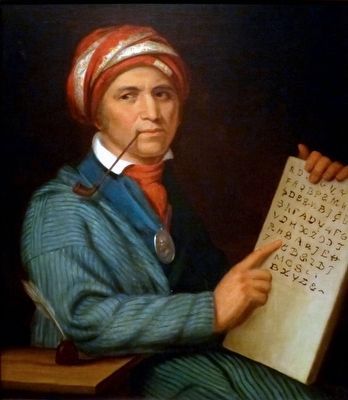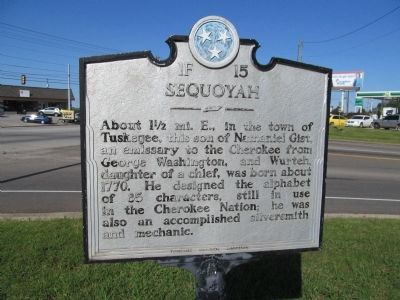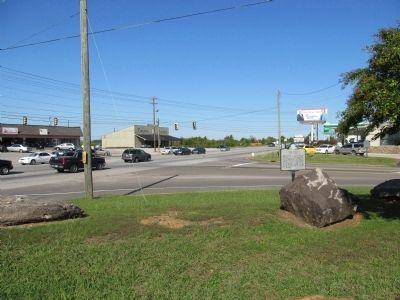Vonore in Monroe County, Tennessee — The American South (East South Central)
Sequoyah
Erected by Tennessee Historical Commission. (Marker Number 1F 15.)
Topics and series. This historical marker is listed in this topic list: Native Americans. In addition, it is included in the Tennessee Historical Commission series list. A significant historical year for this entry is 1770.
Location. 35° 35.487′ N, 84° 14.036′ W. Marker is in Vonore, Tennessee, in Monroe County. Marker is at the intersection of Tennessee Route 360 and U.S. 411, on the left when traveling north on State Route 360. Touch for map. Marker is in this post office area: Vonore TN 37885, United States of America. Touch for directions.
Other nearby markers. At least 8 other markers are within 2 miles of this marker, measured as the crow flies. Cherokee Villages (within shouting distance of this marker); Fort Loudon (approx. 0.7 miles away); Overhill Fur & Hide Trade (approx. 1.3 miles away); Cherokee Heritage Trails (approx. 1.3 miles away); Unicoi Turnpike Trail (approx. 1.3 miles away); Welcome to Fort Loudoun State Historic Area (approx. 1.6 miles away); a different marker also named Unicoi Turnpike Trail (approx. 1.6 miles away); Fort Loudoun (approx. 1.6 miles away). Touch for a list and map of all markers in Vonore.

Photographed By Allen C. Browne, February 16, 2015
3. Sequoyah
This c. 1830 portrait of Sequoyah by Henry Inman after Charles Bird King hangs in the National Portrait Gallery in Washington, DC.
“Born Cherokee town of Tuskegee, eastern Tennessee, Sequoyah, the son of a Cherokee chief's daughter and a fur trader from Virginia, was a warrior and hunter and, some say, a silversmith. For twelve years he worked to devise a method of writing for the Cherokee language. His syllabary of eighty-five symbols representing vowel and consonant sounds was approved by the Cherokee chiefs in 1821. The simple utilitarian system made possible a rapid spread of literacy throughout the Cherokee nation. Medicine men set down ceremonies for healing, divination, war, and traditional ball games; missionaries translated hymns and the New Testament into the native language; and in 1828 the Cherokee Phoenix, a weekly bilingual newspaper, began publication at New Echota, Georgia.
The original portrait of Sequoyah, commissioned by Thomas McKenney and painted by Charles Bird King, was destroyed by the fire that swept through the Smithsonian Castle building in January 1865.” — National Portrait Gallery
“Born Cherokee town of Tuskegee, eastern Tennessee, Sequoyah, the son of a Cherokee chief's daughter and a fur trader from Virginia, was a warrior and hunter and, some say, a silversmith. For twelve years he worked to devise a method of writing for the Cherokee language. His syllabary of eighty-five symbols representing vowel and consonant sounds was approved by the Cherokee chiefs in 1821. The simple utilitarian system made possible a rapid spread of literacy throughout the Cherokee nation. Medicine men set down ceremonies for healing, divination, war, and traditional ball games; missionaries translated hymns and the New Testament into the native language; and in 1828 the Cherokee Phoenix, a weekly bilingual newspaper, began publication at New Echota, Georgia.
The original portrait of Sequoyah, commissioned by Thomas McKenney and painted by Charles Bird King, was destroyed by the fire that swept through the Smithsonian Castle building in January 1865.” — National Portrait Gallery
Credits. This page was last revised on June 16, 2016. It was originally submitted on October 12, 2012, by Judith Barber of Marietta, Georgia. This page has been viewed 540 times since then and 33 times this year. Photos: 1, 2. submitted on October 12, 2012, by Judith Barber of Marietta, Georgia. 3. submitted on November 14, 2015, by Allen C. Browne of Silver Spring, Maryland. • Bernard Fisher was the editor who published this page.

